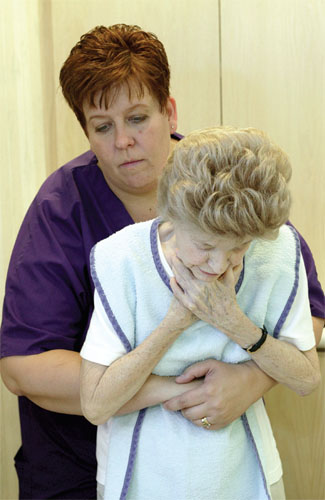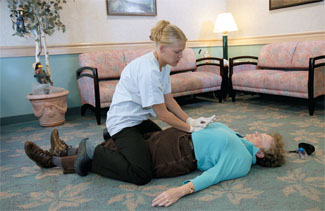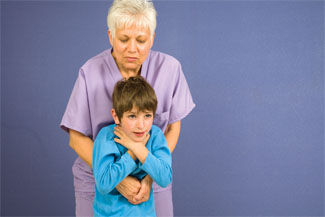Purpose
- Remove a foreign body from obstructing the airway to prevent anoxia and cardiopulmonary arrest.
Assessment
- Identify disorders that put clients at greater risk for airway obstruction:
- Cerebral vascular accident with hemiparesis
- Neuromuscular disorders
- Seizure disorders
- Tumors of neck or esophagus
- Decreased level of consciousness
- Heavy narcotic or sedative use
- Alcohol intoxication
- Diminished or absent cough and gag reflex
- Assess client for signs and symptoms of airway obstruction.
Symptoms not needing immediate intervention:- Ability to speak
- Ability to breathe in and out
- Ability to cough
- Stable vital signs
- Note: Stay with the client and allow him or her to cough to clear airway.
- Universal distress signal for complete airway obstruction
- Irregular, slow, shallow breathing
- Apnea
- High-pitched sounds or no sounds while inhaling
- Inability to cough forcibly or at all
- Inability to speak
- Cyanosis
- Abnormal pulse (irregular, rapid, or slow)
- Determine which variation of the Heimlich maneuver (chest thrusts, abdominal thrusts) to use.
Equipment
- No equipment is mandatory; suction equipment and emergency cart are useful if in hospital setting.
Procedure
Conscious Child or Adult (Heimlich Maneuver)
- The client will be standing or sitting.
- Stand behind the client.
- Wrap your arms around client's waist.
-
Make a fist with one hand. Place thumb side of fist against client's abdomen, above the navel but below the xiphoid process.
Rationale: Proper positioning is important to avoid injury and to successfully clear the airway.
- Grasp fist with other hand.
-
Press fist into abdomen with a quick upward thrust (Fig. 1).
Rationale: A quick upward thrust increases intrathoracic pressure and creates an artificial cough, which forces air and foreign objects out of the airway.
- Repeat distinct separate thrusts until the client expels the foreign body or becomes unconscious.

Fig. 1: Place your fist just above the person's navel and below the sternum.
Unconscious Client (Heimlich Maneuver, Abdominal Thrust)
- Client will be lying on the ground.
-
Turn client on back and call for help. Activate emergency response system.
Rationale: Prompt access to trained emergency professionals can be life-saving.
-
Finger sweep.
-
Use tongue-jaw lift to open mouth.
Rationale: Tongue-jaw lift draws tongue away from back of throat to relieve obstruction or visualize foreign body.
- Insert index finger inside cheek and sweep to base of tongue if an object is visible. Use a hooking motion if possible to dislodge and remove the foreign body. Note: Avoid finger sweeps in infants and children because you can easily push the foreign body further into the airway. Remove only if clearly visible and easy to reach.
-
If there is no effective breathing, attempt to provide 2 rescue breaths. If unsuccessful, reposition and try to ventilate again.
Rationale: Ventilation, if possible, would reduce hypoxia.
-
Use tongue-jaw lift to open mouth.
- Straddle client's thighs or kneel to the side of thighs.
- Place heel of one hand on epigastric area, midline above the navel but below the xiphoid process.
-
Place second hand on top of first hand.
Rationale: Proper positioning is important to avoid injury and successfully clear the airway.
-
Press heel of hand into abdomen with a quick upward thrust. Note: Be careful to thrust in the midline to prevent injury to the liver or spleen (Fig. 2).
Rationale: A quick upward thrust increases intrathoracic pressure and creates an artificial cough to force air and foreign body out of airway.
- Repeat abdominal thrusts 5 times.
- If airway is still obstructed, attempt to ventilate using mouth-to-mouth respiration and head tilt/chin lift.
- Repeat Steps 5 through 8 until successful.

Fig. 2: Abdominal thrusts.
Children Younger Than 1 Year of Age (Back Blows and Chest Thrusts)
- Straddle infant over your arm with head lower than trunk.
- Support head by holding jaw firmly in your hand.
- Rest your forearm on your thigh and deliver five back blows with the heel of your hand between the infant's scapula.
- Place free hand on infant's back and support neck while turning to supine position.
- Place two fingers over sternum in same location as for external chest compression (one fingerwidth below nipple line).
- Administer five chest thrusts.
- Repeat Steps 1 through 6 until airway is not obstructed.
Children Older Than 1 Year of Age
- Perform Heimlich maneuver with child standing, sitting, or lying as for adult, but more gently (Fig. 3).
- You may need to kneel behind child or have child stand on a table.
-
Prevent foreign body airway obstruction in infants and children by teaching parents or caregivers to:
- Restrict children from walking, running, or playing with food or foreign objects in their mouths.
- Keep small objects (e.g., marbles, beads, beans, thumb tacks) away from children younger than 3 years of age.
- Avoid feeding popcorn and peanuts to children younger than 3 years of age, and cut other foods into small pieces.
- Instruct parents and caregivers in the management of foreign body airway obstruction.

Fig. 3: Place thumb side of fist against child's abdomen below xiphoid; press fist into abdomen with quick, upward thrusts.
Pregnant Women or Very Obese Adults (Chest Thrusts)
- Stand behind client.
- Bring your arms under client's armpits and around chest.
- Make a fist and place thumb side against middle of sternum.
- Grasp fist with other hand and deliver a quick backward thrust (Fig. 4).
- Repeat thrusts until airway is cleared.
- Chest thrusts may be performed with client supine and hands positioned with heel over lower half of sternum (as for cardiac compression). Administer separate downward thrusts until airway is clear

Fig. 4: Performing Heimlich maneuver on pregnant woman.
| Sample Documentation | |||
| 09/03/10 | 1300 | Heimlich maneuver performed after choking episode while eating lunch. Did not lose consciousness. MD notified, saw client and ordered swallowing evaluation. S. Roberts, RN | |
Life-Span Considerations
Infant and Child- Infants and young children have airways that are easily occluded by a small amount of secretions. The nasal airway is smaller in diameter, the epiglottis is higher, and the tongue is proportionately larger.
- A bulb syringe is often used to aspirate secretions from an infant's nasal and oral cavities. This procedure is clean, rather than sterile, because the trachea is not entered.
Collaboration and Delegation
- All healthcare personnel should be trained and proficient in the Heimlich maneuver, especially those who are working with high-risk groups (e.g., feeding CVA or neurologically impaired clients. Bi-yearly updates and validation for proficiency should be mandatory.